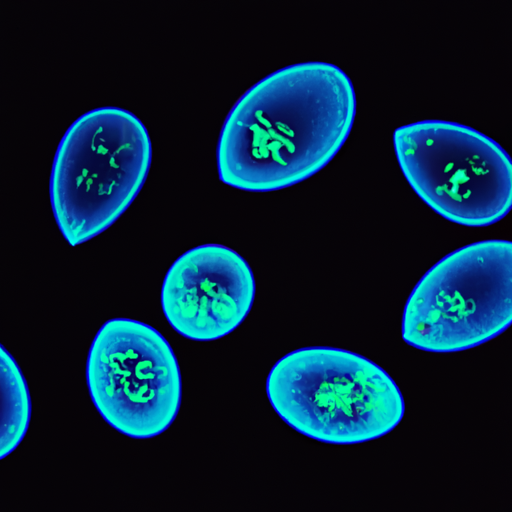
SCPA-EN-00093 "Luminescent Parasitic Organisms"
SCPA-EN-00093 Report
Item #: SCPA-EN-00093
Object Class: Euclid
Special Containment Procedures:
SCPA-EN-00093 instances are to be contained in a standard biotic containment unit at Bio-Research Area-5. The containment unit must be filled with saltwater and kept at a temperature between 15°C to 20°C at all times to prevent the organisms from dying. The containers must also have high-efficiency particulate air (HEPA) filters to ensure no SCPA-EN-00093-1 instances escape.
Researchers and personnel handling SCPA-EN-00093 instances must wear full-body suits, including gloves and respirators, when interacting with the organisms. Any personnel displaying signs of infection must be quarantined immediately.
All experiments conducted on SCPA-EN-00093 must be approved by at least two Level 3 personnel.
Description:
SCPA-EN-00093 refers to a collection of bioluminescent, parasitic organisms known as SCPA-EN-00093-1. SCPA-EN-00093-1 instances are small, worm-like creatures measuring approximately 10 centimeters in length. SCPA-EN-00093-1 can be found in the intestines of various marine organisms, including fish, turtles, and whales.
When SCPA-EN-00093-1 reaches maturity, they will exit the host organism and seek a new host. SCPA-EN-00093-1 can communicate with other instances of SCPA-EN-00093-1 over long distances using bioluminescence. SCPA-EN-00093-1 will make their way to the mouth of the host organism and use their bioluminescence to attract potential new hosts to eat them.
Once consumed by a new host organism, SCPA-EN-00093-1 will attach themselves to the walls of the new host's intestine and begin to reproduce. SCPA-EN-00093-1 consumes the host's nutrients, causing weakness and eventual death if left unchecked.
SCPA-EN-00093 was discovered when a group of fishermen reported strange, glowing fish in their nets. Follow-up investigations revealed widespread infection of marine organisms along the coast. All infected marine organisms died within three weeks of infection.
Additional Information:
SCPA-EN-00093-1 instances can also infect humans, though not through consumption. During an experiment, Researcher Jameson accidentally ingested an SCPA-EN-00093-1 instance while collecting a sample. The instance attached itself to the walls of Jameson's intestines and began to reproduce. Jameson displayed symptoms of nutrient deficiency within days and was quarantined. Jameson died six weeks after initial infection when SCPA-EN-00093-1 instances caused a blockage in his intestines.
SCPA-EN-00093-1 instances can also communicate with one another using radio waves. It is currently unclear as to why SCPA-EN-00093-1 instances possess this ability.
References:
SCPA-EN-00093 Experiment Log
Classification level:
Level 3
Notice:
All personnel must follow standard biohazard containment procedures when dealing with SCPA-EN-00093. Infection or suspected infection must be reported to the Bio-Research Area-5 Head Researcher immediately. No experiments on SCPA-EN-00093 are to be conducted without approval from at least two Level 3 personnel.
Record #:
Incident Report: SCPA-EN-00093 Infection of Researcher Jameson
Reporter:
Dr. Sarah Adams, Bio-Research Area-5 Head Researcher
Approver:
Site Director Johnson
Additional research into SCPA-EN-00093 "Luminescent Parasitic Organisms"
Additional research is underway...
【注意事項】
この文書は、人工知能によって生成されたものであり、SCPA財団が取り扱う奇妙な存在や現象についての報告書として作成されました。
本文書に記載された内容や画像は、フィクションであるため、実在の人物や団体とは一切関係がありません。SCPA財団は、この文書を公開することで、一般の人々にSCPA財団が取り扱う異常な存在や現象について知識を提供することを目的としています。
SCPA財団は、本文書の使用に伴う一切の責任を負いかねます。
【Notice】
This document was created as a report on strange beings and phenomena handled by the SCPA Foundation, generated by artificial intelligence.
The contents and images described in this document are fictional and are not related to any real individuals or organizations. The SCPA Foundation aims to provide knowledge to the general public about abnormal beings and phenomena handled by the SCPA Foundation by publishing this document.
The SCPA Foundation cannot be held responsible for any use of this document.
